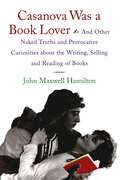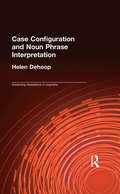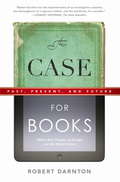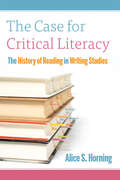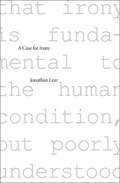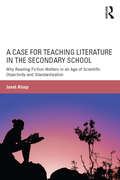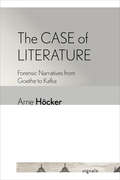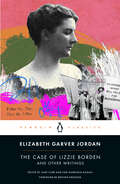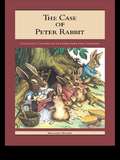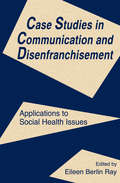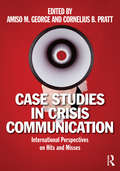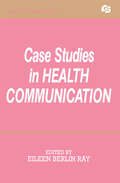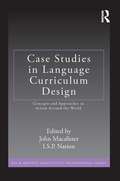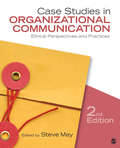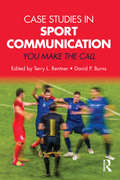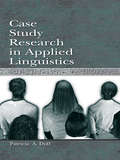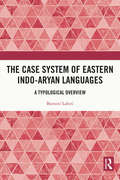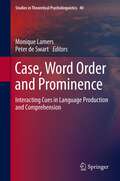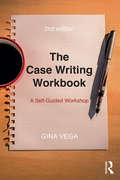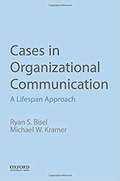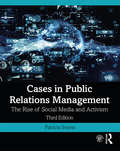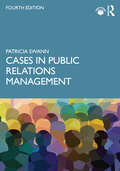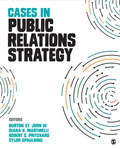- Table View
- List View
Casanova Was A Book Lover: And Other Naked Truths and Provocative Curiosities about the Writing, Selling, and Reading of Books
by John Maxwell HamiltonEveryone knows which books people buy; they can just look at the best-seller lists. But who knows which books people steal? Who, for that matter, knows that authors ruin the book market by writing too much? Or why book critics are not critical? Or why librarians need to throw out more books? Who, indeed, knows the answer to that all-important question in our democracy: should presidents and presidential candidates write books? (The answer is no.)In this irreverent analysis of the book industry, John Maxwell Hamilton -- a longtime journalist and public radio commentator -- answers these questions and many more, proving that the best way to study books is not to take them too seriously. He provides a rich history of the book -- from the days when monks laboriously hand-copied texts to the tidal wave of Titanic tie-ins -- and gives a succinct overview of the state of the industry today, including writing, marketing, promoting, reviewing, ghostwriting, and collecting.Throughout, Hamilton peppers his prose with spicy tidbits of information that will fascinate bibliophiles everywhere. For instance, did you know that Walt Whitman was fired from a government job because his boss found Leaves of Grass, and its author, immoral? Or that the most stolen book in the United States is the Bible, followed by The Joy of Sex? How about that Dan Quayle's 1989 Christmas card read, "May our nation continue to be a beakon of hope to the world"? Or that Casanova was an ardent lover of books as well as women?Hamilton offers an inside look at the history and business of book reviewing, explaining why, more often than not, reviewers resemble "counselors at a self-esteem camp" and examining the enormous impact of the "Oprah effect" on the market. As the self-appointed Emily Post of the book world, he advises publishers, authors, and readers on proper etiquette for everything from book parties ("Feel free to build a party around a theme in a book, no matter how tacky") and jacket photos ("You should not show off your new baby unless [your] book [is] about raising kids"), to book signings ("Just because an author has given you an autograph does not mean they want to become your pen pal") and promotion by friends and relatives ("They should carry the book at all times on public transportation with the cover showing").Both edifying and enjoyable, Casanova Was a Book Lover fills a Grand Canyon--sized void in the literature on literature. It is indispensable for book enthusiasts who want to know the naked truth about reading, writing, and publishing.
Case, Argument Structure, and Word Order (Routledge Leading Linguists)
by Shigeru MiyagawaOver the years, a major strand of Miyagawa's research has been to study how syntax, case marking, and argument structure interact. In particular, Miyagawa's work addresses the nature of the relationship between syntax and argument structure, and how case marking and other phenomena help to elucidate this relationship. In this collection of new and revised pieces, Miyagawa expands and develops new analyses for numeral quantifier stranding, ditransitive constructions, nominative/genitive alternation, "syntactic" analysis of lexical and syntactic causatives, and historical change in the accusative case marking from Old Japanese to Modern Japanese. All of these analyses demonstrate an intimate relation among case marking, argument structure, and word order.
Case Configuration and Noun Phrase Interpretation (Outstanding Dissertations in Linguistics)
by Helen DehoopFirst Published in 1997. Routledge is an imprint of Taylor & Francis, an informa company.
The Case for Books: Past, Present, and Future
by Robert DarntonThe era of the printed book is at a crossroad. E-readers are flooding the market, books are available to read on cell phones, and companies such as Google, Amazon, and Apple are competing to command near monopolistic positions as sellers and dispensers of digital information. Already, more books have been scanned and digitized than were housed in the great library in Alexandria. Is the printed book resilient enough to survive the digital revolution, or will it become obsolete? In this lasting collection of essays, Robert Darnton?an intellectual pioneer in the field of this history of the book?lends unique authority to the life, role, and legacy of the book in society.
The Case for Critical Literacy: A History of Reading in Writing Studies
by Alice S. HorningThe Case for Critical Literacy explores the history of reading within writing studies and lays the foundation for understanding the impact of this critical, yet often untaught, skill. Every measure of students’ reading comprehension, whether digital or analog, demonstrates that between 50 and 80 percent of students are unable to capture the substance of a full discussion or evaluate material for authority, accuracy, currency, relevancy, appropriateness, and bias. This book examines how college-level instruction reached this point and provides pedagogical strategies that writing instructors and teachers can use to address the problem. Alice Horning makes the case for the importance of critical reading in the teaching of writing with intentionality and imagination, while sharing glimpses of her own personal history with reading and writing. Horning provides the context for understanding what college faculty face in their classrooms and offers a history of critical literacy that explains why, to date, it has mostly neglected or ignored the diverse statuses of students’ reading challenges. The Case for Critical Literacy explores actionable options to better meet students’ literacy needs. College and university faculty, especially writing instructors, will benefit from an understanding of what has happened in the field and what needs to change.
A Case for Irony
by Jonathan LearIn 2001, Vanity Fair declared that the Age of Irony was over. Joan Didion has lamented that the United States in the era of Barack Obama has become an "irony-free zone. " Jonathan Lear in his 2006 book Radical Hope looked into Americaâe(tm)s heart to ask how might we dispose ourselves if we came to feel our way of life was coming to an end. Here, he mobilizes a squad of philosophers and a psychoanalyst to once again forge a radical way forward, by arguing that no genuinely human life is possible without irony. Becoming human should not be taken for granted, Lear writes. It is something we accomplish, something we get the hang of, and like Kierkegaard and Plato, Lear claims that irony is one of the essential tools we use to do this. For Lear and the participants in his Socratic dialogue, irony is not about being cool and detached like a player in a Woody Allen film. That, as Johannes Climacus, one of Kierkegaardâe(tm)s pseudonymous authors, puts it, âeoeis something only assistant professors assume. âe Instead, it is a renewed commitment to living seriously, to experiencing every disruption that shakes us out of our habitual ways of tuning out of life, with all its vicissitudes. While many over the centuries have argued differently, Lear claims that our feelings and desires tend toward order, a structure that irony shakes us into seeing. Learâe(tm)s exchanges with his interlocutors strengthen his claims, while his experiences as a practicing psychoanalyst bring an emotionally gripping dimension to what is at stakeâe"the psychic costs and benefits of living with irony.
A Case for Teaching Literature in the Secondary School: Why Reading Fiction Matters in an Age of Scientific Objectivity and Standardization
by Janet AlsupTaking a close look at the forces that affect English education in schools—at the ways literature, cognitive science, the privileging of the STEM disciplines, and current educational policies are connected—this timely book counters with a strong argument for the importance of continuing to teach literature in middle and secondary classrooms. The case is made through critical examination of the ongoing "culture wars" between the humanities and the sciences, recent research in cognitive literary studies demonstrating the power of narrative reading, and an analysis of educational trends that have marginalized literature teaching in the U.S., including standards-based and scripted curricula. The book is distinctive in presenting both a synthesis of arguments for literary study in the middle and high school and sample lesson plans from practicing teachers exemplifying how literature can positively influence adolescents’ intellectual, emotional, and social selves.
The Case for Terence Rattigan, Playwright
by John A. BertoliniThis book asserts the extraordinary quality of mid-twentieth century playwright Terence Rattigan's dramatic art and its basis in his use of subtext, implication, and understatement. By discussing every play in chronological order, the book also articulates the trajectory of Rattigan's darkening vision of the human potential for happiness from his earlier comedies through his final plays in which death appears as a longed for peace. New here is the exploration through close analysis of Rattigan's style of writing dialogue and speeches, and how that style expresses Rattigan's sense of life. Likewise, the book newly examines how Rattigan draws on sources in Greek and Roman history, literature, and myth, as well as how he invites comparison with the work of other playwrights, especially Bernard Shaw and Shakespeare. It will appeal broadly to college and university students studying dramatic literature, but also and especially to actors and directors, and the play-going, play-reading public.
The Case of Literature: Forensic Narratives from Goethe to Kafka (Signale: Modern German Letters, Cultures, and Thought)
by Arne HöckerIn The Case of Literature, Arne Höcker offers a radical reassessment of the modern European literary canon. His reinterpretations of Goethe, Schiller, Büchner, Döblin, Musil, and Kafka show how literary and scientific narratives have determined each other over the past three centuries, and he argues that modern literature not only contributed to the development of the human sciences but also established itself as the privileged medium for a modern style of case-based reasoning.The Case of Literature deftly traces the role of narrative fiction in relation to the scientific knowledge of the individual from eighteenth-century psychology and pedagogy to nineteenth-century sexology and criminology to twentieth-century psychoanalysis. Höcker demonstrates how modern authors consciously engaged casuistic forms of writing to arrive at new understandings of literary discourse that correspond to major historical transformations in the function of fiction. He argues for the centrality of literature to changes in the conceptions of psychological knowledge production around 1800; legal responsibility and institutionalized forms of decision-making throughout the nineteenth century; and literature's own realist demands in the early twentieth century.
The Case of Lizzie Borden and Other Writings: Tales of a Newspaper Woman
by Elizabeth Garver JordanThe first and only comprehensive collection of writings by Elizabeth Garver Jordan, the groundbreaking journalist, suffragist, and editor whose fearless reporting on women preceded the #MeToo movement and popularized the true-crime genreA Penguin ClassicThe Case of Lizzie Borden and Other Writings is the first to collect Garver Jordan&’s fiction and journalism, much of which has been out of print for over a century. Jordan began her career as a reporter, making her name as one of few women journalists to cover the Lizzie Borden murder trial for the New York World in 1893. Jordan&’s distinctive, narrative-driven coverage of the Borden and other high-profile murder cases brought her national visibility, and she turned increasingly to fiction writing. Drawing on her experiences as a true-crime reporter and newspaper editor, she published detective novels and short story collections such as Tales of the City Room that explored the fine line between women&’s criminality and crimes against women. Employing popular genre conventions as a means of dealing with women&’s issues, Jordan exposed gendered abuse in the workplace and the prevalence of sexual violence. The Case of Lizzie Borden and Other Writings encourages readers to draw a historical trajectory from Jordan&’s pioneering literary activism to the writings of contemporary journalists and novelists whose work continues to fuel discussions of gender, feminism, and crime, raising questions about who gets to tell women&’s stories, especially in the wake of the #MeToo movement.
The Case of Peter Rabbit: Changing Conditions of Literature for Children (Children's Literature and Culture #7)
by Margaret MackeyFirst published in 1998. Routledge is an imprint of Taylor & Francis, an informa company.
Case Studies in Communication and Disenfranchisement: Applications To Social Health Issues (Routledge Communication Series)
by Eileen Berlin RaySee blurb for Communication and Disenfranchisement. Books will be promoted together.
Case Studies in Crisis Communication: International Perspectives on Hits and Misses
by Amiso M. George Cornelius B. PrattCase Studies in Crisis Communication: International Perspectives on Hits and Misses was created to fill the gap for a much-needed textbook in case studies in crisis communication from international perspectives. The events of September 11, 2001, other major world crises, and the ongoing macroeconomic challenges of financial institutions, justify the need for this book. While existing textbooks on the subject focus on U.S. corporate cases, they may not appeal equally to students and practitioners in other countries, hence the need to analyze cases from the United States and from other world regions. The variety and the international focus of the cases, be they environmental, health or management successes or failures, makes this book more appealing to a wider audience. These cases examine socio-cultural issues associated with responding to a variety of crises.
Case Studies in Health Communication: A Case Study Approach (Routledge Communication Series)
by Eileen Berlin RayThis book focuses on the complexities of the communication of health-related messages and information through the use of case studies. The expert contributors to this volume are scholars who, during their research and consulting, grapple with many of the issues of concern to those studying health communication. While several introductory books offer brief case studies to illustrate concepts covered, this book provides in-depth cases that enable more advanced students to apply theory to real situations.
Case Studies in Language Curriculum Design: Concepts and Approaches in Action Around the World (ESL & Applied Linguistics Professional Series)
by John Macalister I.S.P. NationCase studies are a powerful pedagogical tool for illuminating constructs and models in real-life contexts. Covering a wide range of teaching-learning contexts and offering in-depth analyses of ESL/ELT language curriculum design issues, this casebook is distinctive and unique in that each case draws on and is clearly linked to a single model presented in Nation and Macalister’s Language Curriculum Design (www.routledge.com/9780415806060), giving the book a high degree of coherence. A short commentary by the editors after each case highlights features of note and/or issues arising from it. This is a versatile text, designed to work as a companion to Language Curriculum Design (adding meaning and depth to the model presented there by relating it to a range of applications), as a stand-alone text, or as a resource for language teacher trainees, teacher educators, practicing teachers, program administrators, and materials writers in the field.
Case Studies in Organizational Communication: Ethical Perspectives and Practices
by Steve MayThe Second Edition of Case Studies in Organizational Communication: Ethical Perspectives and Practices, by Dr. Steve May, integrates ethical theory and practice to help strengthen readers' awareness, judgment, and action in organizations by exploring ethical dilemmas in a diverse range of well-known business cases.
Case Studies in Sport Communication: You Make the Call
by Terry L. Rentner David P. BurnsCase Studies in Sport Communication: You Make the Call goes beyond the box scores by offering readers the opportunity to evaluate popular and diverse issues in sport—including management, crisis, health, ethics, gender, race, and social media. Each chapter incorporates theory and communication principles as well as topical background information, and concludes with discussion questions and engaging assignments. This volume presents real-life, provocative sports cases that bring contemporary headlines into perspective and inspire critical thinking. Each chapter features scholarly evidence that will keep the conversation lively, thoughtful, and informative. Students are encouraged to challenge the ethical implications of what they have read and to “make the call.” This is an invaluable resource for upper-level undergraduate and graduate students of sport communication and sport management.
Case Study Research in Applied Linguistics (Second Language Acquisition Research Ser.)
by Patricia DuffCase studies of individual language learners are a valuable means of illustrating issues connected with learning, using, and in some cases, losing another language. Yet, even though increasing numbers of graduate students and scholars conduct research using case studies or mix quantitative and qualitative methods, there are no dedicated applied lin
The Case System of Eastern Indo-Aryan Languages: A Typological Overview
by Bornini LahiriThis book presents a typological overview of the case system of Eastern Indo-Aryan (EIA) languages. It utilizes a cognitive framework to analyse and compare the case markers of seven EIA languages: Angika, Asamiya, Bhojpuri, Bangla, Magahi, Maithili and Odia. The book introduces semantic maps, which have hitherto not been used for Indian languages, to plot the scope of different case markers and facilitate cross-linguistic comparison of these languages. It also offers a detailed questionnaire specially designed for fieldwork and data collection which will be extremely useful to researchers involved in the study of case. A unique look into the linguistic traditions of South Asia, the book will be indispensable to academicians, researchers, and students of language studies, linguistics, literature, cognitive science, psychology, language technologies and South Asian studies. It will also be useful for linguists, typologists, grammarians and those interested in the study of Indian languages.
Case, Word Order and Prominence: Interacting Cues in Language Production and Comprehension (Studies in Theoretical Psycholinguistics #40)
by Monique Lamers Peter De SwartLanguage users have access to several sources of information during the build up of a meaningful construction. These include grammatical rules, situational knowledge, and general world knowledge. A central role in this process is played by the argument structure of verbs, which establishes the syntactic and semantic relationships between arguments. This book provides an overview of recent psycholinguistic and theoretical investigations on the interplay between structural syntactic relations and role semantics. The focus herein lies on the interaction of case marking and word order with semantic prominence features, such as animacy and definiteness. The interaction of these different sorts of information is addressed from theoretical, time-insensitive, and incremental perspectives, or a combination of these. Taking a broad cross-linguistic perspective, this book bridges the gap between theoretical and psycholinguistic approaches to argument structure.
The Case Writing Workbook: A Self-Guided Workshop
by Gina VegaThis book offers a modular set of chapters that focus specifically on the challenges related to case writing. Exercises, worksheets, and training activities help guide readers sequentially through the entire process of writing both a case and an instructor’s manual (teaching note). Designed as an individualized workshop to assist case authors to structure their writing, this book combines the easy-to-understand, student-focused language of the first edition with new material covering the latest developments and challenges in the world of case writing. These include: ? A section on writing cases in condensed time frames ? A new module on writing short cases in various formats ? A new module on turning research papers into teaching tools ? A section about growing communities of practice in a university ? An expansion of the student case writing module to include a section on case writing for graduate students ? Twelve new worksheets ? A complete index to facilitate use of the book Finishing all the book’s assignments will result in a complete case and instructor’s manual that can be tested in the classroom and submitted to a conference or journal. The Case Writing Workbook is a must for the shelf of any academic or student conducting qualitative research and looking to enhance their skill set.
Cases in Organizational Communication: A Lifespan Approach
by Ryan S. Bisel Michael W. KramerCase Studies in Organizational Communication: A Lifespan Approach is the first collection of its kind that is designed to complement a textbook (the editors' Organizational Communication: A Lifespan Approach, OUP, 2016). Bringing concepts to life by engaging readers' minds, memories, and emotions, this volume provides students and instructors with a wealth of opportunities to see, hear, and feel how communication can and does shape organizations and the experiences of people within them.
Cases in Public Relations Management: The Rise of Social Media and Activism
by Patricia SwannNow in its third edition, Cases in Public Relations Management uses recent cases in strategic communication designed to encourage discussion, debate, and exploration of the options available to today's strategic public relations manager, with the help of extensive supplemental materials. Key features of this text include coverage of the latest controversies in current events, discussion of the ethical issues that have made headlines in recent years, and strategies used by public relations practitioners. The problem-based case study approach encourages readers to assess what they know about communication theory, the public relations process, and management practices. New to the third edition: Eighteen new cases including Snap, Wells Fargo, SeaWorld, United Airlines, and Starbucks. Additional emphasis on social media and social responsibility for communication management today. End-of-chapter activities that reinforce concepts. Developed for advanced students in strategic communication and public relations, this book prepares them for their future careers as communication and public relations professionals. The new edition features a fully enhanced companion website that includes resources for both instructors and students. Instructors will find PowerPoint Lecture Slides, Case Supplements, Instructor Guides, and Answer Keys for Quizzes and End-of-Chapter Activities. Students will benefit from Quizzes, a Glossary, and Case Supplements.
Cases in Public Relations Management
by Patricia SwannThis fourth edition of Cases in Public Relations Management features a combination of new and tried-and-tested cases that give students a practical view of how on-the-ground public relations is practiced today.Showcasing both successes and failures in public relations management, this text uses a problem-based case study approach that encourages readers to put their knowledge to the test to assess what has worked and consider alternate approaches to the situations these cases explore. It features questions for discussion and prompts to “dig deeper” into the cases at hand. New to the fourth edition: Fifteen new cases, including Anheuser-Busch InBev, Dove, Juul, FTX, Norfolk Southern, Barbie, and Nike Emphasis on social media, sustainability, ethics, and social responsibility for communication management today End-of-chapter activities that reinforce concepts Developed for advanced students in strategic communication and public relations, this book prepares them for their future careers as communication and public relations professionals.The fourth edition features fully updated online resources: student case guides with case supplements, instructor case guides with sample answers to end of case questions in the text, and PowerPoint lecture slides. Please visit www.routledge.com/9781032163642.
Cases in Public Relations Strategy
by Burton St. John Dr Diana Knott Martinelli Mr Robert S. Pritchard Cylor A. SpauldingCases in Public Relations Strategy, by Burton St. John III, Diana K. Martinelli, Robert S. Pritchard, and Cylor Spaulding, draws on original, real-world case studies to provide you with a strategic approach to meeting the needs of a client before, during, and beyond a campaign. Using the RACE (Research, Action Planning, Communication, and Evaluation) model, you will explore successful contemporary campaigns and evaluate best practices in all major areas of public relations activity. This practical, client-oriented text shows you how to systematically evaluate and adapt to the needs of a particular client—whether big or small, global or local, for-profit or nonprofit—in order to launch the most effective campaign. Each case includes a brief introduction focused on fundamentals and core competencies, and all cases have been carefully selected to present a wide range of client types. In addition to the lessons from professionals in the case studies, a section on PR consulting and an appendix on advancing your PR career give you the knowledge and skills you need for success in the field.
